ahmedwaqas92
ODI Debutant
- Joined
- Dec 26, 2013
- Runs
- 10,582
- Post of the Week
- 4
Amidst cries for free and fair elect….. Err… I mean comparisons by [MENTION=138254]Syed1[/MENTION], [MENTION=139975]The_Odd_One[/MENTION] and [MENTION=137804]msb314[/MENTION]; I decided to have a go at our present ODI captain’s batting numbers similar to how we dissected Shehzad’s ‘Golden Period’.
It is safe to say that if you enjoyed the previous thread, you’d absolutely adore this one as well . So without further a due here’s Azhar Ali’s Inning by Inning ODI batting statistics since his recall in 2015 up until the present Australian summer.
. So without further a due here’s Azhar Ali’s Inning by Inning ODI batting statistics since his recall in 2015 up until the present Australian summer.
YEAR 2015
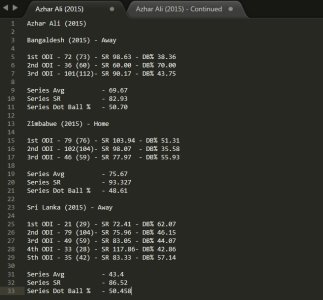

Azhar Ali, as we all are fully aware, was recalled to lead the Pakistan national ODI side after a disappointing 2015 World Cup campaign. His first assignment as the One Day skipper was to lead a relatively inexperienced side on an away tour to Bangladesh which Pakistan lost 3 nil; the series marked the start of Azhar Ali the One Day opener and captain.
At this very moment, during the compilation of the preceding said analysis, Azhar has captained and batted in 10 different series against varying degrees of oppositions in both home and away conditions. Out of the given 10 series 7 were played away, with two being at the U.A.E. and the celebrated tour of Zimbabwe in Pakistan– the list of the tours include:
Now that we have established some meaningful context to our study, we might look at Azhar’s batting stats because that is what this thread is all about, to begin our analysis let us quickly glace over Azhar’s initial batting numbers for the first year of 2015 – The range for these begin at 17th April 2015 since this is the date of 1st ODI in the Bangaldesh away tour up until the end of December, his cumulative numbers are as follows:
In all fairness, for someone who was not even part of the ODI squad in the last 3 odd years, Azhar had almost an extremely healthy restart to his ODI batting career. He was opening the batting, was scoring runs at a decent-ish pace and for the most part his dot ball percentage hovered near 50 percent which is quite acceptable for someone opening the batting and averaging near 45 runs per innings.
Apart from his dreadful series in Zimbabwe, which collaterally took a hit on his overall statistics, and that too for just two games, Azhar had a much steadied 2015 when it came to churning out the numbers. Although the results while captaining were far from ideal, Azhar ‘the batsman’ was an extremely critical cog in the Pakistani ODI lineup.
YEAR 2014
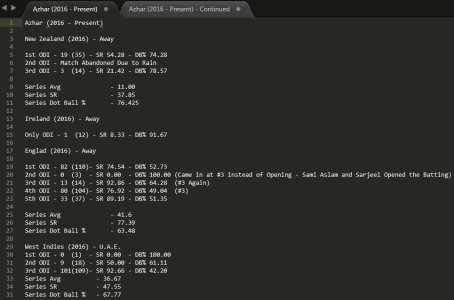
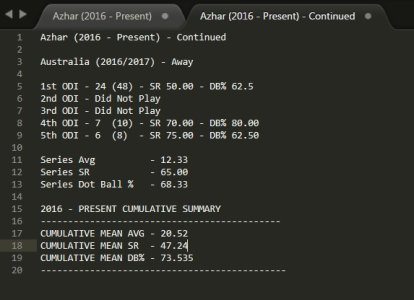
If you think 2015 was the turning point for Azhar ‘the batsman’ then you wouldn’t have been much off from predicting the future. Azhar fortunes did turn – only for the absolute worse. From a batsman who was averaging in the mid-40s having a cumulative SR worth of 75+ in the previous year; Azhar saw the next 12 months averaging 20 runs per innings while conveniently striking under fifty runs per hundred balls.
Doubt that wasn’t enough turmoil?, Azhar’s dot ball percentage additionally increased from 57 percent to nearly 74 percent all within the space of the subsequent twelve months. His series by series metrics also took a sever hit:
These contrasting figures for the last two odd years might suggest that Azhar’s ODI exploits reached a plateau during the 2015 season. He was as confident as ever and at the ripe age of 30 cashed in on his form and experience to make merry during the entire cricketing season.
The narrative changed significantly when Azhar for the first time since his comeback had a loss of form starting with the bilateral away tour of New Zealand in the beginning of 2016. Ever since then, Azhar has found extremely hard to make a string of scores consistently without letting his Strike Rate and Dot Ball percentage suffer much.
To check whether our Hypothesis is correct on the matter, I did a trend analysis (similar to how I presented Shehzad’s case) for his cumulative numbers on average, strike rate and dot ball percentage. Added to these I further plotted three graphical representations on the tabulated results so that we may know the direction of the trend as well.
Cumulative Numbers
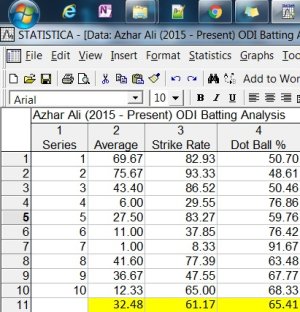
Batting Averages
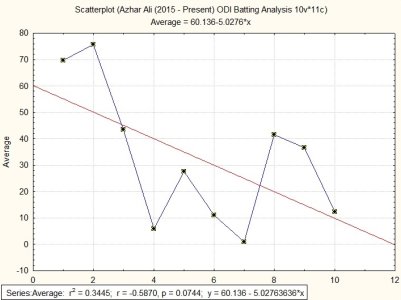
Strike Rate
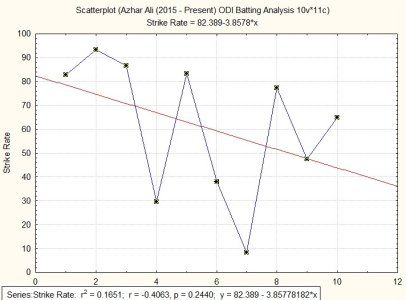
Dot Ball %
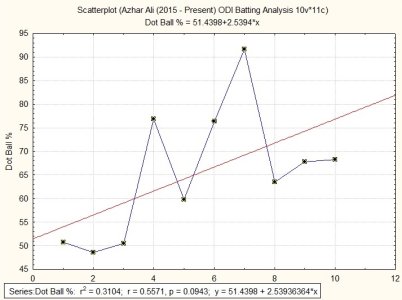
As we can clearly see from the above trends Azhar’s batting metrics are in a steep decline, his average has a negative slope of -5 which suggests that he has been in a spiraling slump of form for a good number of games now.
Another feature of note is the downward trend for the SR and the upward trend for the Dot ball Percentage. These two progressions in tandem highlight that Azhar’s limited ability as an LOI batsman might be catching up to him plus with the departure of his honeymoon period in 2015 he is really starting to find it horrendously difficult to make any impact on the ODIs he features in.
Similar to Shehzad Azhar too suffers from lack of consistency and the same is extremely evident in the large coefficient value on all three equations. The scatter points are way off from the line of best fit.
P.S. A few posters brought it up earlier about the SR issue, please note that the strike rate used to calculate this progression is based on cumulative figures which means that I take an aggregate mean from all the strike rates that the batsmen have accumulated during the series – This is slightly different from actual strike rate which takes into account runs made per 100 balls. The strike rate calculated here is to normalize data and quite frankly if you score a GOD DAMN DUCK then it should reflect into your overall number rather than those ‘wasted’ balls being adjusted into the innings the batsman might have score.
To put it shortly, just think of the difference between batting average and average runs made per innings that considers 1 innings as 1 dismissal and disregards not outs.
It is safe to say that if you enjoyed the previous thread, you’d absolutely adore this one as well
YEAR 2015


Azhar Ali, as we all are fully aware, was recalled to lead the Pakistan national ODI side after a disappointing 2015 World Cup campaign. His first assignment as the One Day skipper was to lead a relatively inexperienced side on an away tour to Bangladesh which Pakistan lost 3 nil; the series marked the start of Azhar Ali the One Day opener and captain.
At this very moment, during the compilation of the preceding said analysis, Azhar has captained and batted in 10 different series against varying degrees of oppositions in both home and away conditions. Out of the given 10 series 7 were played away, with two being at the U.A.E. and the celebrated tour of Zimbabwe in Pakistan– the list of the tours include:
Code:
Opposition | Result | Venue
Bangladesh | Lost | Away
Zimbabwe | Won | Home (Pakistan)
Sri Lanka | Won | Away
Zimbabwe | Won | Away
England | Lost | U.A.E.
New Zealand | Lost | Away
Ireland | Won | Away
England | Lost | Away
West Indies | Won | U.A.E.
Australia | Lost | AwayNow that we have established some meaningful context to our study, we might look at Azhar’s batting stats because that is what this thread is all about, to begin our analysis let us quickly glace over Azhar’s initial batting numbers for the first year of 2015 – The range for these begin at 17th April 2015 since this is the date of 1st ODI in the Bangaldesh away tour up until the end of December, his cumulative numbers are as follows:
Code:
Opposition | Avg | SR | DB%
Bangladesh | 69.67 | 82.93 | 50.70
Zimbabwe | 75.67 | 93.33 | 48.61
Sri Lanka | 43.40 | 86.52 | 50.46
Zimbabwe | 6.00 | 29.55 | 76.86
England | 27.50 | 83.26 | 59.76
Aggregate Mean | 44.45 | 75.11 | 57.28In all fairness, for someone who was not even part of the ODI squad in the last 3 odd years, Azhar had almost an extremely healthy restart to his ODI batting career. He was opening the batting, was scoring runs at a decent-ish pace and for the most part his dot ball percentage hovered near 50 percent which is quite acceptable for someone opening the batting and averaging near 45 runs per innings.
Apart from his dreadful series in Zimbabwe, which collaterally took a hit on his overall statistics, and that too for just two games, Azhar had a much steadied 2015 when it came to churning out the numbers. Although the results while captaining were far from ideal, Azhar ‘the batsman’ was an extremely critical cog in the Pakistani ODI lineup.
YEAR 2014


If you think 2015 was the turning point for Azhar ‘the batsman’ then you wouldn’t have been much off from predicting the future. Azhar fortunes did turn – only for the absolute worse. From a batsman who was averaging in the mid-40s having a cumulative SR worth of 75+ in the previous year; Azhar saw the next 12 months averaging 20 runs per innings while conveniently striking under fifty runs per hundred balls.
Doubt that wasn’t enough turmoil?, Azhar’s dot ball percentage additionally increased from 57 percent to nearly 74 percent all within the space of the subsequent twelve months. His series by series metrics also took a sever hit:
Code:
Opposition | Avg | SR | DB%
New Zealand | 11.00 | 37.85 | 76.42
Ireland | 1.00 | 8.33 | 91.67
England | 41.60 | 77.39 | 63.48
West Indies | 36.67 | 47.55 | 67.77
Australia | 12.33 | 65.00 | 68.33
Cumulative | 20.52 | 47.22 | 73.53These contrasting figures for the last two odd years might suggest that Azhar’s ODI exploits reached a plateau during the 2015 season. He was as confident as ever and at the ripe age of 30 cashed in on his form and experience to make merry during the entire cricketing season.
The narrative changed significantly when Azhar for the first time since his comeback had a loss of form starting with the bilateral away tour of New Zealand in the beginning of 2016. Ever since then, Azhar has found extremely hard to make a string of scores consistently without letting his Strike Rate and Dot Ball percentage suffer much.
To check whether our Hypothesis is correct on the matter, I did a trend analysis (similar to how I presented Shehzad’s case) for his cumulative numbers on average, strike rate and dot ball percentage. Added to these I further plotted three graphical representations on the tabulated results so that we may know the direction of the trend as well.
Cumulative Numbers

Batting Averages

Strike Rate

Dot Ball %

As we can clearly see from the above trends Azhar’s batting metrics are in a steep decline, his average has a negative slope of -5 which suggests that he has been in a spiraling slump of form for a good number of games now.
Another feature of note is the downward trend for the SR and the upward trend for the Dot ball Percentage. These two progressions in tandem highlight that Azhar’s limited ability as an LOI batsman might be catching up to him plus with the departure of his honeymoon period in 2015 he is really starting to find it horrendously difficult to make any impact on the ODIs he features in.
Similar to Shehzad Azhar too suffers from lack of consistency and the same is extremely evident in the large coefficient value on all three equations. The scatter points are way off from the line of best fit.
Code:
Average => y = 60.136 - 50276x
SR => y = 82.389 - 3.8578x
DB% => y = 2.539x + 51.4398P.S. A few posters brought it up earlier about the SR issue, please note that the strike rate used to calculate this progression is based on cumulative figures which means that I take an aggregate mean from all the strike rates that the batsmen have accumulated during the series – This is slightly different from actual strike rate which takes into account runs made per 100 balls. The strike rate calculated here is to normalize data and quite frankly if you score a GOD DAMN DUCK then it should reflect into your overall number rather than those ‘wasted’ balls being adjusted into the innings the batsman might have score.
To put it shortly, just think of the difference between batting average and average runs made per innings that considers 1 innings as 1 dismissal and disregards not outs.

















 His SR in WI Tour 2016 wasnt 47.55 , but was 85.94 which quite puts a dent in the beautiful Rolls Royce........
His SR in WI Tour 2016 wasnt 47.55 , but was 85.94 which quite puts a dent in the beautiful Rolls Royce........